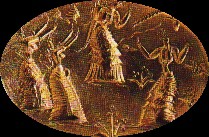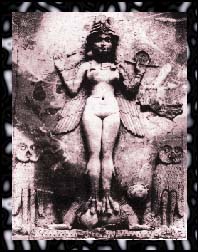 |
|
|
We have chosen as a starting point for our collaboration the Sumerian text, The Descent Of Inanna To the Underworld, because this ancient story contains many elements of universal relevance in the contemporary world. The text (estimated 4000 to 6000 years old) was discovered early in the 20th century on tablets that archaeologists date back to around 1750 BC, from the ancient kingdom of Sumer (Mesopotamia). It predates the Babylonian myth of Ishtar and Tammuz, and the Greek myth of Persephone. Read Diane Wolkstein's translation of the story.
The Me Sumerian
cuneiform for Me: The seven Me are the powers of the gods, the visible symbols of god-like powers; the concept can also be understood as universal decrees of divine authority. In this story, the Me are represented by Inanna's crown, multiple strands of beads, the royal robe, breastplate, gold ring and measuring rod (sceptre); and these are what Inanna must relinquish in order to enter the underworld.
The story In the middle of her reign as Queen of Heaven and Earth, Inanna decides to descend into the underworld - the realm of death, ruled by her dark sister Ereshkigal. In preparation, she instructs her minister, the goddess Ninshubar, to expect her return in three days. If she doesn’t come back, Ninshubar is to lament and beat the drum for her.
Ereshkigal and the seven judges of the underworld surround the now-powerless goddess and pass judgment against her. Because she has trespassed the realm of the dead, she too must die. She is killed and left as a rotting corpse hanging on a meat hook. After three days and three nights, Ninshubar sets up a lament, beating her drum to petition the gods for Inanna’s return. Enki, the water god of wisdom, sends two asexual spirits to free Inanna: first they gainEreshkigal's favour by empathising with her, then they sprinkle the water of life over Inanna. Resurrected, she is allowed to leave on one condition: she must send a replacement for herself to the underworld. Inanna’s consort, Dumuzi, has taken advantage of her absence to consolidate his own power. So in retribution, Inanna sends him to the underworld as her replacement. But Dumuzi’s sister, Gestinanna, bargains with Inanna to make a deal that Gestinanna will take his place for six months out of the year. Before her journey, Inanna knows all that there is to know in her realm, but there is another world that she has no access to – the Great Below, kingdom of her dreaded sister, Ereshkigal, Queen of the Underworld. There is no need to make the descent, no vital reason to take on such a terrible journey. No need at all except the experience of incompleteness in herself, and the demanding desire to know what one does not know, the desire to experience one’s own depths or personal hell. Inanna risks the descent and through her relinquishment, death, and resurrection, she becomes more than merely the Goddess of Heaven and Earth. She has conquered the Underworld as well and has become complete.
The mythological text describes ancient rituals of death and rebirth in nature. During the Bronze Age, the Mother Earth goddess is widely present in all civilization; in later times her figure and symbolism is still present and integrated into various religions but restricted and distorted by the patriarchal hegemony. The focus on pre-Christian goddesses is not only about female power but also explores crafts and tales shaped from a different knowledge and perception of the nature of life and death. Inanna’s epic journey offers space for various interpretations and gives us the challenge of recreating the missing pieces of the mosaic through the performing arts. |
|
|
the project | inanna | the artists | home |
|
 Inanna
must pass through seven gates in her descent, which are guarded
by Neti, the Gatekeeper. At each gate, she must surrender
elements of the Me.
By the time she reaches the throne room of Ereshkigal in the cave-like
underworld, Inanna has been stripped naked and humbled.
Inanna
must pass through seven gates in her descent, which are guarded
by Neti, the Gatekeeper. At each gate, she must surrender
elements of the Me.
By the time she reaches the throne room of Ereshkigal in the cave-like
underworld, Inanna has been stripped naked and humbled. The
search for Inanna’s traces follows the myths of ancient Goddesses
of Earth, in particular in Southern Europe and the Mediterranean: Demeter,
Cybele, Rhea, Hera and Egyptian Hator.
The
search for Inanna’s traces follows the myths of ancient Goddesses
of Earth, in particular in Southern Europe and the Mediterranean: Demeter,
Cybele, Rhea, Hera and Egyptian Hator.